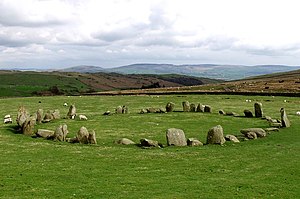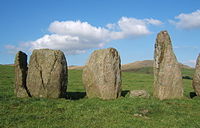Swinside

Swinside, which is also known as Sunkenkirk and Swineshead,[1] is a stone circle found beside Swinside Fell, part of Black Combe in southern Cumberland, dating from the Neolithic Age.
This is one of several stone circles amongst the fells of Cumberland, which include the Castlerigg stone circle and Long Meg and Her Daughters. Constructed from local slate, the ring has a diameter of about 94 feet,[2][3] and currently contains 55 stones, although when originally constructed there probably would have been around 60.[2] An entrance-exit was included on the monument's south-eastern side, which was defined by the inclusion of two outer portal stones.
In the Early Modern period, local folklore about the stones held that they had once been used in the construction of a church, but that the Devil continually thwarted these plans, creating the stone circle in the process. Archaeological investigation into the monument began in the early 20th century, with an excavation taking place in 1901.
Location
- Location map: 54°16’57"N, 3°16’26"W
- Streetmap: SD172882
The stone circle at Swinside is located in the south-west corner of the Lake District, five miles north of the town of Millom.[2] The site can only be reached by travelling on foot.[2] To reach the site, the visitor must get to Crag Hall, where there is limited places for parking, and then walk along a rough track for a mile and a quarter uphill towards Swinside Farm, where the circle lies to the right of the path.[3]
Megalithic specialist Aubrey Burl called Swinside "the loveliest of all the circles" in north-western Europe.[4] In his study of the stone circles of Lakeland, the archaeologist John Waterhouse commented that Swinside "can be compared only to Castlerigg and Long Meg and her Daughters in its visual impact; but its charm – for great charm it undoubtedly has – is greater even than theirs."[3]
Construction

The stones used in the construction of Swinside are porphyritic slate collected from the adjacent fells, and are of the type that was known locally as 'grey cobbles' by the 20th century.[2][3] The ring has a diameter of about 94 feet,[2][3] and currently contains 55 stones, although when originally constructed there probably would have been around 60.[2]
Swinside's builders included a "well defined" entrance, 7 feet wide, at the south-eastern side, which was signalled by the placing of two large portal stones outside the circumference of the circle.[2] Such portal openings can also be found at other stone circles in the Lake District, such as Long Meg and Her Daughters.[2] These features are also found in stone circles in Dumfriesshire.[5] In particular, Swinside has a number of features in common with the Girdle Stanes.[5][6]
Folklore
Local folklore holds that at night, the Devil would pull down the stones of a church that was being constructed in the daytime, in the process creating the stone circle; it is for this reason that the site has also been called Sunkenkirk.[3][7]
In the 1930s, it was recorded that there was a local belief that it was impossible to count all of the stones.[8]
Antiquarian and archaeological investigation
The first archaeological excavation at Swinside was carried out from midday on Tuesday 26 March 1901 through to the evening of the following day. During this excavation, two crosstrenches were dug, each 18 inches wide, covering just over one-thirteenth of the interior of the site. The excavators reported finding a lump of charcoal and a piece of decayed bone.[7]
See also
- Birkrigg stone circle, 12 miles to the southeast
- Grey Croft stone circle, 12 miles to the northwest
Outside links
| ("Wikimedia Commons" has material about Swinside) |
- Swinside stone circle at Megalithia.com.
- Images of and notes about Sunkenkirk at The Modern Antiquarian.
References
- ↑ Lewis 1886. p. 475.
- ↑ 2.0 2.1 2.2 2.3 2.4 2.5 2.6 2.7 2.8 Burl 2005. p. 48.
- ↑ 3.0 3.1 3.2 3.3 3.4 3.5 Waterhouse 1985. p. 43.
- ↑ Burl 1979. p. 235.
- ↑ 5.0 5.1 Burl, Aubrey: 'The Stone Circles of Britain, Ireland and Brittany' (Yale University Press, 2000) page 194
- ↑ Burl, pages 121–123
- ↑ 7.0 7.1 Burl 2005. p. 49. Cite error: Invalid
<ref>tag; name "burl49" defined multiple times with different content - ↑ Grinsell 1976. p. 165.
Bibliography
- Academic books
- Burl, Aubrey (1979). Rings of Stone. London: Francis Lincoln. ISBN 978-0-517-34723-2.
- Burl, Aubrey (2000). The Stone Circles of Britain, Ireland and Brittany. New Haven and London: Yale University Press. ISBN 978-0-300-08347-7.
- Burl, Aubrey (2005). A Guide to the Stone Circles of Britain, Ireland and Brittany. New Haven and London: Yale University Press. ISBN 978-0-300-11406-5.
- Bradley, Richard (1998). The Significance of Monuments: On the Shaping of Human Experience in Neolithic and Bronze Age Europe. London: Routledge. ISBN 978-0-415-15204-4.
- Grinsell, Leslie V. (1976). Folklore of Prehistoric Sites in Britain. London: David & Charles. ISBN 0-7153-7241-6.
- Hutton, Ronald (1991). The Pagan Religions of the Ancient British Isles: Their Nature and Legacy. Oxford and Cambridge, Massachusetts: Blackwell. ISBN 978-0-631-17288-8.
- Parker Pearson, Michael (2005). Bronze Age Britain (Revised Edition). London: B.T. Batsford and English Heritage. ISBN 978-0-7134-8849-4.
- Waterhouse, John (1985). The Stone Circles of Cumbria. Chichester: Phillimore. ISBN 978-0-85033-566-8.
- Academic papers and articles
- Dymond, C.W.: 'A group of Cumberland megaliths': Transactions of the Cumberland and Westmorland Antiquarian and Archaeological Society, 1879–81 Volume V, pages 39–57, 1879–81
- Lewis, A.L. (1886). "On Three Stone Circles in Cumberland, with Some Further Observations on the Relation of Stone Circles to Adjacent Hills and Outlying Stones". The Journal of the Anthropological Institute of Great Britain and Ireland 15: 471–481.
- Richards, Colin (1996). "Monuments as Landscape: creating the centre of the world in late Neolithic Orkney". World Archaeology (London: Routledge) 28: 190–208. doi:10.1080/00438243.1996.9980340.
- Watson, Aaron (2001). "Composing Avebury". World Archaeology (London: Routledge) 33 (2): 296–314. doi:10.1080/00438240120079307.
